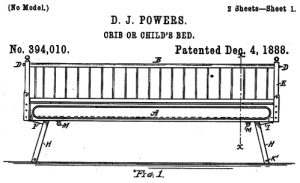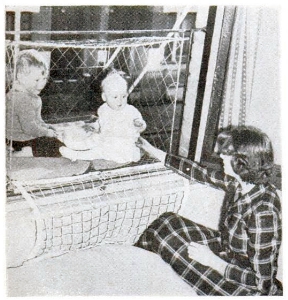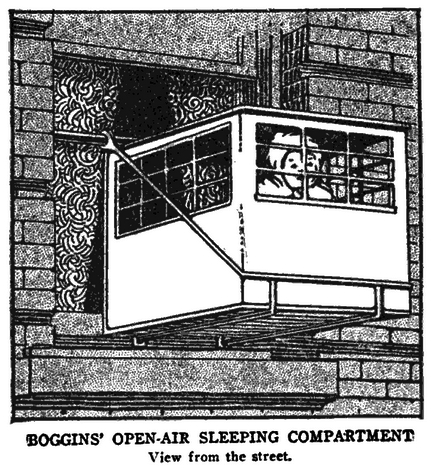Where I live we are “bracing” for a winter storm. People are raiding grocery store shelves like there will be no tomorrow. Trust me, it won’t be as big a deal as everyone is making it out to be (I hope). In honor of the upcoming West Texas “snowmageddon” I thought I’d share a story featured in the February 2018 issue of Digging History Magazine. Enjoy!
This article may very well make you think, “you must be kidding! Seriously?”
To begin with I came upon this story in a rather roundabout way. So, in a roundabout way let me explain. It started with a Christmas sermon about Baby Jesus and how the manger (a feeding trough) served as his crib. The minister explained that in those days there was no such thing as a crib as we know it today. Interestingly, the Old English word “crib” means “manger” or “stall”.
However, it wasn’t until sometime in the nineteenth century when baby cribs came into use. Where did the little one sleep before the 1800s? Though it sounds ill-advised today, children often slept with their mother.
A primary feature of the crib was the ability to keep the child from falling out of bed, necessitating the need for a device which could be easily lowered and raised to place or remove the child. For instance, on December 4, 1888 David J. Powers was awarded U.S. Patent 394010 for a crib or child’s bed. Powers explained:
 My improved child’s crib is preferably constructed with a frame having sufficient high sides, upon which the folding panels are hinged to permit the panels to fold down.1
My improved child’s crib is preferably constructed with a frame having sufficient high sides, upon which the folding panels are hinged to permit the panels to fold down.1
After these types of cribs were invented and improved upon there were other devices, with accompanying theories of proper child-rearing, which began to pop up in the late nineteenth and early twentieth centuries. Here’s a depiction of a “baby cage” invented by Emma Read of Spokane, Washington in 1922 and patented (#1448235) the following year.
 If the image looks a little odd just sort of hanging out there, it’s because it was designed to hang that way – outside a window! These cages began to take off in the 1930s, especially in London (not exactly the healthiest air quality in the world at that time). The July 1953 issue of Popular Mechanics depicted a baby cage accompanied with a description of its purpose:
If the image looks a little odd just sort of hanging out there, it’s because it was designed to hang that way – outside a window! These cages began to take off in the 1930s, especially in London (not exactly the healthiest air quality in the world at that time). The July 1953 issue of Popular Mechanics depicted a baby cage accompanied with a description of its purpose:
 Apartment-Window Cage Protects English Tots
Apartment-Window Cage Protects English Tots
Enclosed in a wire cage suspended from an apartment window, English children play in the sunlight and fresh air while their mothers are busy with housework. The cage, made of wire netting, is strongly braced and is guarded on the apartment side by a cloth net which prevents children from crawling back into the room. Loaned by an infant welfare center to families with no gardens, the portable balcony is apparently popular with children and mothers. The demand exceeds the supply.2
The idea of “airing” one’s baby came about in the late nineteenth century as Dr. Luther Emmett Holt explained the concept in his 1894 book, The Care and Feeding of Children. In a chapter entitled “Airing” Holt wrote:
Of what advantage to the child is going out? Fresh air is required to renew and purify the blood, and this is just as necessary for health and growth as proper food.
What are the effects produced in infants by fresh air? The appetite is improved, the digestion is better, the cheeks become red, and all signs of health are seen. . .
What are the objections to an infant’s sleeping out of doors? There are no real objections. It is not true that infants take cold more easily when asleep than awake, while it is almost invariably the case that those who sleep out of doors are stronger children and less prone to take cold than others.3
It would seem the so-called baby cage was in use before Emma Read’s invention in 1922, however. In his book entitled The Health Care of the Baby: A Handbook for Mothers and Nurses, Dr. Louis Fischer, also stressing the importance of fresh air, included illustrations of a device called “Boggins’ Open-Air Sleeping Compartment”, one a view from the street and the other from the inside room.
In 1906 the concept of “airing” one’s baby seems to have taken an extreme turn. In June of that year a women’s club in St. Paul, Minnesota was hosting a clinic on “The Care of Infants and How to Make Child Rearing Easy”. The headline proclaimed:
FROST YOUR BABE, MOTHER’S ADVICE
Clubwomen in St. Paul Told That Chilly Treatment Will Make Their Infants Fat
SNOWBANK BEST CRADLE
Models Shown of “Cage” to Keep Baby In When Mother Attends Meeting of the Club4
Frost your babe? Snowbank best cradle? What was that about!?!
Mrs. Winona S. Abbott was the “expert” and she had been brought to the club meeting by Mrs. Lydia Avery Coonley Ward of Chicago. All ladies present were in St. Paul for a convention of the General Federation of Women’s Clubs, founded in 1890. President Sarah Platt Decker had announced the day before that Mrs. Abbott knew everything there was to know about babies and their care.
There were both married and single women in attendance, clamoring to know more from the “expert”. Some were mother-in-laws with an intense interest in their grandchildren, while some were just struggling with the stresses of raising children.
Mrs. Abbott came well-prepared and stood ready to demonstrate the cadre of “patented appliances for the use of young mothers”.5 She proclaimed a so-called “mechanical baby tender” could mechanically care for the babe whilst its momma attended her club meeting, thus reducing “maternal cares to a minimum and place club life within the reach of all”.6
The newspaper’s description seems to indicate the device was a crib, resembling a cage without a top. Since the mid-1800s several devices deemed “baby tenders” had been patented. Which one she was referring to is unclear, however.
The bars were made of white willow, about two and a half feet high. On one side was a rack for a milk bottle and the other a rack for a rattle. Go ahead and leave little Johnny in the “baby tender” and run off to your club meeting – just make sure he has milk and rattler!
Everything that could possibly keep an infant entertained or provided for was within its grasp. It was noted, however, there was no compartment for “soothing sirup [sic]” – too deleterious, Mrs. Abbott advised.
Her advice included how to dress a squirming baby, serve a five-course meal without getting up from the table, furnish an entire night’s supply of sterilized milk for your baby without making a six trips to the fridge, prevent children from becoming bowlegged or knock-kneed and how to button your infant to its bed to prevent an accidental fall. Whew! What didn’t this woman know about child care?
As one might imagine Mrs. Abbott had “an inviolable set of bylaws for the government of the babe”.7 Her list included, among other things:
● Never use the “indispensable” safety pin. Use buttons instead.
● Always put clothes on a baby by way of the feet – never via the head.
● Never let a baby cry. Crying does not develop the lungs. No baby will cry if treated rightly.
● Give a baby plenty of physical culture. Begin Indian club exercises as soon as possible.
● Never make a baby’s clothes more than twenty-two inches long. 8
As a staunch advocate of the cold air and chilled water treatment for children, she also recommended the child be set outdoors immediately after birth – even if born in the dead of winter. Wrap it in woolen clothes, place in a Klondike bag, hammock or specially-made box and set it outside in the cold to sleep.
Mrs. Abbott claimed her own child had slept outside in -26 degrees, and all the better for it. At 26 months old the child was able to “hold its own weight on a horizontal bar for a minute and a half”.8 At six months old bundle up the babe and plop him or her out in the snow to enjoy the cold weather. You can always warm them up with a nice warm bath, right?
No, actually, according to Mrs. Abbott not nearly so beneficial as a cold one. Again she held up her (apparently) heart and stout children as stellar examples: “my baby won’t get into the bath unless the water is extremely cold”, she explained. “He will sit in cold water for an hour and a half. I would not mind if he sat there three hours. It would do him good.”9
Drafts, however, were a different kettle of fish altogether. Drafts were dangerous! Take the baby out and wrap it so nary a draft strikes it!
Whether this woman was some sort of quack is certainly debatable. She laughed at her critics. One neighbor in the Illinois town where she lived a few years back had reported her to the authorities when she put her baby out in the snow – and now she had the world’s strongest baby! Furthermore, one of her sons had been born paralyzed from the waist down. Currently he was playing football for the University of Illinois, she claimed.
She brought out a prototype of a baby cage and explained the important features necessary to make it effective, claiming it would be a perfectly safe place for the baby to entertain itself – and leaving it there whilst mommy went to her club meeting, one woman piped up! “Exactly!”, exclaimed Mrs. Abbott. That was the point wasn’t it – Mommy need not be inconvenienced in any way in order to pursue her women’s club interest.
What about when the child can scale the two and a half foot “fence”? Mrs. Abbott (she had an answer for every challenge it seemed!) advised, “well, then take a clothes line and tie him to a post. I kept one of my boys tied with a clothes line until he was 6 years old.”10
One of the last devices she displayed was a buffet to be placed next to the bed, although it wasn’t stipulated in the article whether it was mommy’s or baby’s bed. Mrs. Abbott explained how the compartments on either side could hold up to twelve bottles of sterilized milk (a 24-hour supply) – everything needed to make it through the night, plus an upper compartment to hold medicines and a heater over which cereals could be placed. By morning breakfast cereal would be ready!
How much of her advice was taken seriously isn’t clear. Other than her appearance at the women’s club convention there are few (if any) references found for her – except a mocking little poem:
Rest little dear, in the ice chest now, snug as a chop, or a steak, or a roast; Mamma will sing you to sleep, somehow – Wonder which of us will chill the most! Tuck your toes where the chilblains are; Dear little nose – it is nice and blue! Baby must go to the Sleepland afar; Listen and mamma will sing to you. Woo-oo-oo! Br-r-r-r! Woo-oo-oo!11
The baby cage appears to have gained growing interest, however. In 1908 it was suggested in order to keep a baby out of mischief, just saw off the top of a barrel around the first hoop and take out every other stave. Voilà, your own DIY baby cage!
Of course, Emma Read wasn’t the only person to try and design a better baby cage. William Gibbs McAdoo, son-in-law of Woodrow Wilson, constructed an out-the-window cage for his months-old daughter. The son of Wilson’s Republican opponent Charles Hughes, Charles Hughes, Jr., heard about it and decided to give it a try.
Hughes’ children were rolled out in a wagon and placed inside the cage where they would spend their morning nap time. In the afternoon they were taken out to play with their toys. Save for a rainy day the cage worked quite well, although a little cold weather was no problem. Charles Hughes III was said to have become rather husky using this treatment. 12
So, the sermon about Baby Jesus and his manger (crib) led me to write this article – in a roundabout way. The more I read and researched the stranger it became. It’s hard to imagine such practices today – whether throwing your baby out in a snowbank or putting them in a baby cage!
Did you enjoy this article? This is a sample of the kinds of stories you’ll find in each issue of Digging History Magazine. The issue is available by single issue purchase. Subscriptions are the best way to enjoy Digging History Magazine, now published bi-monthly and averaging 75-85 pages (or more!). No ads, just stories of interest to history buffs and genealogists. Want to try a free issue? Pick up one (or two) here: Free Samples.
- David J. Powers, 1888, Crib of Child’s Bed, U.S. Patent 394010, filed March 22, 1886 and issued December 4, 1888.
- “Apartment-Window Cage Protects English Tots”, Popular Mechanics, July 1953, 130.
- Dr. Luther Emmett Holt, The Care and Feeding of Children (New York and London: D. Appleton and Company, 1905), 24-25.
- Chicago Tribune, 06 Jun 1906, accessed 12/24/17 at newspapers.com, p. 1.
- Ibid.
- Ibid.
- Ibid.
- Ibid.
- Chicago Tribune, June 6, 1906, 4.
- Ibid.
- Detroit Free Press, June 9, 1906, accessed at www.newspapers.com on January 23, 2018, 4.
- Idaho Statesman, June 24, 1916, accessed at www.genealogybank.com on December 24, 2017, 4.



Neat story good job!
Thank you Rick and thanks for stopping by!